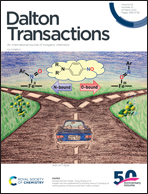Lanthanide clusters of phenanthroline containing a pyridine–pyrazole based ligand: magnetism and cell imaging†
Abstract
In this contribution, we report the synthesis, characterization and luminescence–magnetic properties of Ln-clusters (Ln = Gd3+, Eu3+ and Tb3+) using a new pyridine–pyrazole functionalized ligand fitted with a chromophoric phenanthroline backbone. The unorthodox N-rich ligand forms isostructural trinuclear lanthanide complexes with a topology that closely resembles two interdigitating hairpins. The clusters crystallize in chiral space groups and also exhibit chirality for bulk samples, which were further confirmed using solid state CD spectra. Magnetic studies on the complexes reveal their interesting features while the Gd cluster shows a significant cryogenic magnetic cooling behaviour with a moderately high magnetic entropy change of −23.42 J kg−1 K−1 at 7 T and 2 K. On the other hand, Eu and Tb complexes exhibit interesting fluorescence properties. The compounds were subsequently used as fluorescent probes for the imaging of human breast adenocarcinoma (MCF7) cells. Live cell confocal microscopy images show that the complexes penetrate beyond the usual cytoplasm region and can be useful in imaging the nucleus region of MCF7 cells.



 Please wait while we load your content...
Please wait while we load your content...